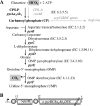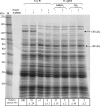Expression of the pyr operon of Lactobacillus plantarum is regulated by inorganic carbon availability through a second regulator, PyrR2, homologous to the pyrimidine-dependent regulator PyrR1
- PMID: 17041052
- PMCID: PMC1698236
- DOI: 10.1128/JB.00985-06
Expression of the pyr operon of Lactobacillus plantarum is regulated by inorganic carbon availability through a second regulator, PyrR2, homologous to the pyrimidine-dependent regulator PyrR1
Abstract
Inorganic carbon (IC), such as bicarbonate or carbon dioxide, stimulates the growth of Lactobacillus plantarum. At low IC levels, one-third of natural isolated L. plantarum strains are nutritionally dependent on exogenous arginine and pyrimidine, a phenotype previously defined as high-CO2-requiring (HCR) prototrophy. IC enrichment significantly decreased the amounts of the enzymes in the pyrimidine biosynthetic pathway encoded by the pyrR1BCAa1Ab1DFE operon, as demonstrated by proteomic analysis. Northern blot and reverse transcription-PCR experiments demonstrated that IC levels regulated pyr genes mainly at the level of transcription or RNA stability. Two putative PyrR regulators with 62% amino acid identity are present in the L. plantarum genome. PyrR1 is an RNA-binding protein that regulates the pyr genes in response to pyrimidine availability by a mechanism of transcriptional attenuation. In this work, the role of PyrR2 was investigated by allelic gene replacement. Unlike the pyrR1 mutant, the DeltapyrR2 strain acquired a demand for both pyrimidines and arginine unless bicarbonate or CO2 was present at high concentrations, which is known as an HCR phenotype. Analysis of the IC- and pyrimidine-mediated regulation in pyrR1 and pyrR2 mutants suggested that only PyrR2 positively regulates the expression levels of the pyr genes in response to IC levels but had no effect on pyrimidine-mediated repression. A model is proposed for the respective roles of PyrR1 and PyrR2 in the pyr regulon expression.
Figures





Similar articles
-
Repression of the pyr operon in Lactobacillus plantarum prevents its ability to grow at low carbon dioxide levels.J Bacteriol. 2005 Mar;187(6):2093-104. doi: 10.1128/JB.187.6.2093-2104.2005. J Bacteriol. 2005. PMID: 15743958 Free PMC article.
-
Lactobacillus plantarum response to inorganic carbon concentrations: PyrR2-dependent and -independent transcription regulation of genes involved in arginine and nucleotide metabolism.Microbiology (Reading). 2008 Sep;154(Pt 9):2629-2640. doi: 10.1099/mic.0.2008/018184-0. Microbiology (Reading). 2008. PMID: 18757797
-
Uracil salvage pathway in Lactobacillus plantarum: Transcription and genetic studies.J Bacteriol. 2006 Jul;188(13):4777-86. doi: 10.1128/JB.00195-06. J Bacteriol. 2006. PMID: 16788187 Free PMC article.
-
Low carbamoyl phosphate pools may drive Lactobacillus plantarum CO2-dependent growth phenotype.J Mol Microbiol Biotechnol. 2008;14(1-3):22-30. doi: 10.1159/000107966. J Mol Microbiol Biotechnol. 2008. PMID: 17957107 Review.
-
Regulation of the Bacillus subtilis pyrimidine biosynthetic operon by transcriptional attenuation: control of gene expression by an mRNA-binding protein.Prog Nucleic Acid Res Mol Biol. 1999;62:329-67. doi: 10.1016/s0079-6603(08)60512-7. Prog Nucleic Acid Res Mol Biol. 1999. PMID: 9932459 Review.
Cited by
-
Regulation of the Expression of De Novo Pyrimidine Biosynthesis Genes in Corynebacterium glutamicum.J Bacteriol. 2015 Oct;197(20):3307-16. doi: 10.1128/JB.00395-15. Epub 2015 Aug 10. J Bacteriol. 2015. PMID: 26260458 Free PMC article.
-
Transcriptome analysis of Lactococcus lactis in coculture with Saccharomyces cerevisiae.Appl Environ Microbiol. 2008 Jan;74(2):485-94. doi: 10.1128/AEM.01531-07. Epub 2007 Nov 9. Appl Environ Microbiol. 2008. PMID: 17993564 Free PMC article.
-
Regulation of pyrimidine biosynthetic gene expression in bacteria: repression without repressors.Microbiol Mol Biol Rev. 2008 Jun;72(2):266-300, table of contents. doi: 10.1128/MMBR.00001-08. Microbiol Mol Biol Rev. 2008. PMID: 18535147 Free PMC article. Review.
-
Oxygen relieves the CO2 and acetate dependency of Lactobacillus johnsonii NCC 533.PLoS One. 2013;8(2):e57235. doi: 10.1371/journal.pone.0057235. Epub 2013 Feb 26. PLoS One. 2013. PMID: 23468944 Free PMC article.
-
Regulation of pyr gene expression in Mycobacterium smegmatis by PyrR-dependent translational repression.J Bacteriol. 2007 Sep;189(17):6236-45. doi: 10.1128/JB.00803-07. Epub 2007 Jun 29. J Bacteriol. 2007. PMID: 17601781 Free PMC article.
References
-
- Arsène-Ploetze, F., and F. Bringel. 2004. Role of inorganic carbon on lactic acid bacteria metabolism. Lait 84:45-59.
-
- Bradford, M. M. 1976. A rapid and sensitive method for the quantitation of microgram quantities of protein utilizing the principle of protein-dye binding. Anal Biochem. 72:248-254. - PubMed
-
- Bringel, F., and J. C. Hubert. 2003. Extent of genetic lesions of the arginine and pyrimidine biosynthetic pathways in Lactobacillus plantarum, L. paraplantarum, L. pentosus, and L. casei: prevalence of CO2 dependent auxotrophs and characterization of deficient arg genes in L. plantarum. Appl. Environ. Microbiol. 69:2674-2683. - PMC - PubMed
Publication types
MeSH terms
Substances
Associated data
- Actions
- Actions
LinkOut - more resources
Full Text Sources

